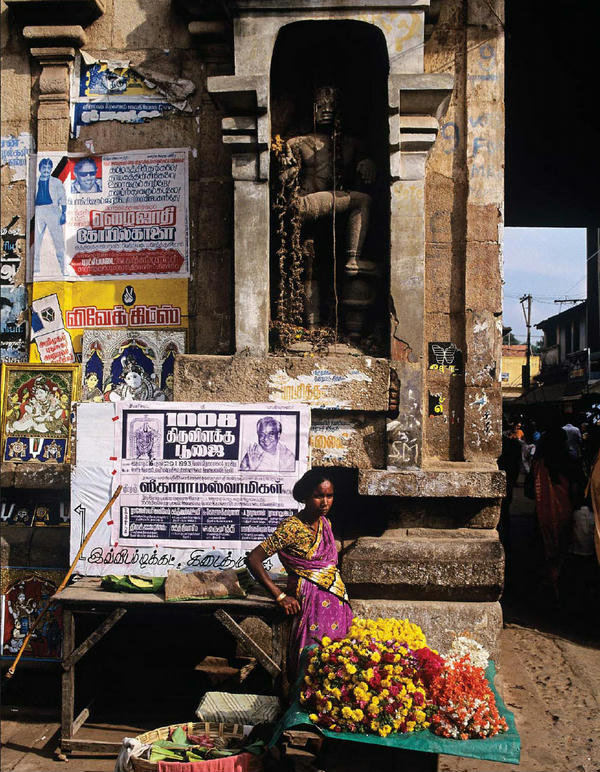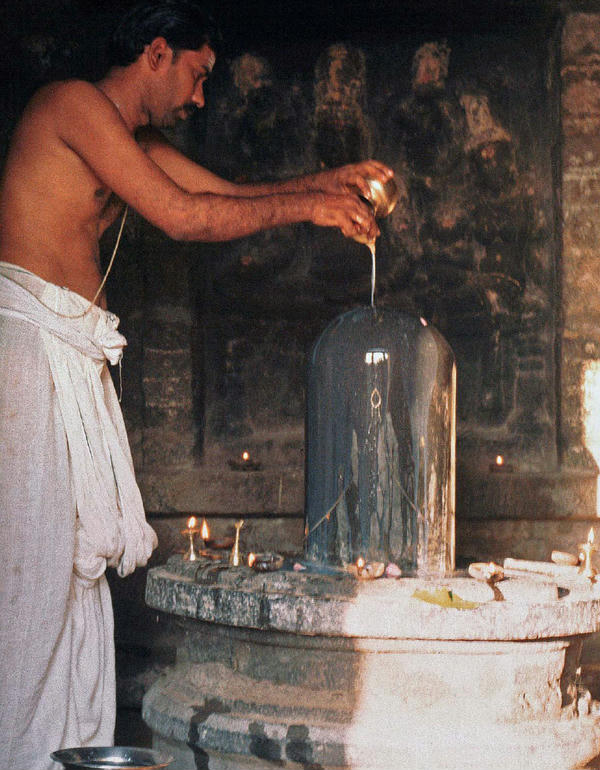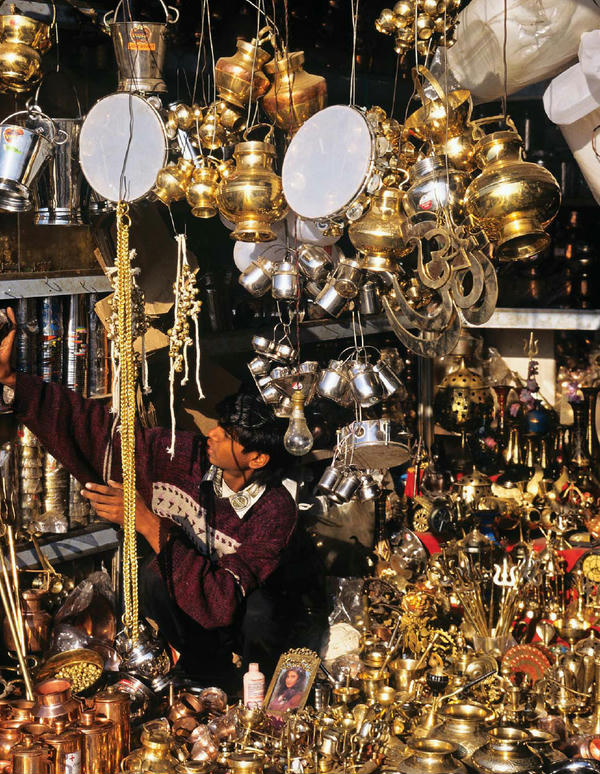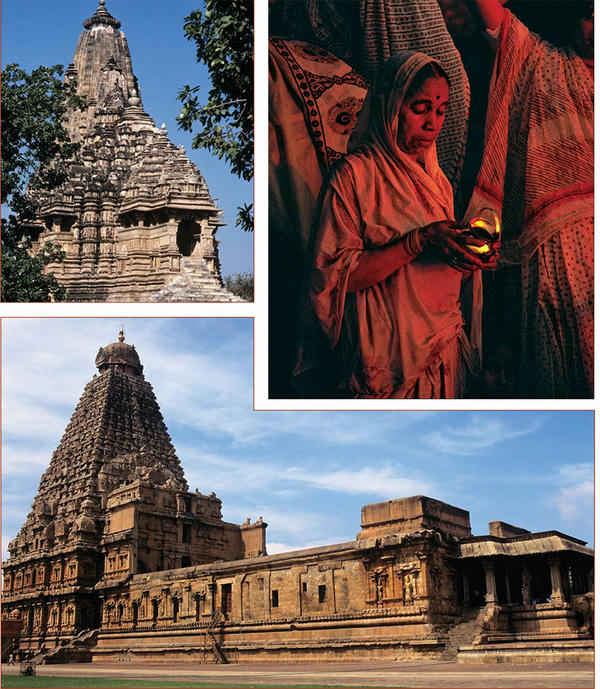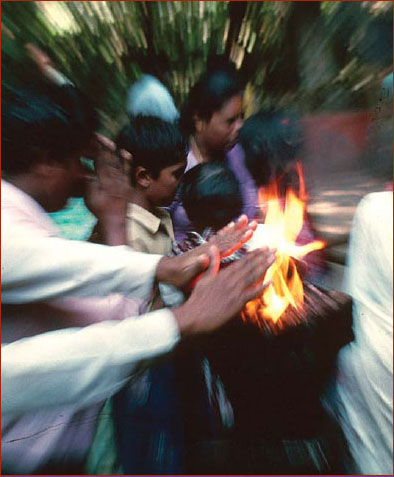II. From Shrine to Temple
 ach temple in India is different: its architecture, decoration, size and contents are unique to its own history and specific purpose. Most are built upon sites that have been in worship for as long as anyone knows. The central image in many is primordial, a natural stone that has been viewed as a God or Goddess for millennia, like the Svayambhu Linga in the temple in the story of Vivek and Manika. The structures around these images have grown up over centuries through the contributions of grateful devotees.§
ach temple in India is different: its architecture, decoration, size and contents are unique to its own history and specific purpose. Most are built upon sites that have been in worship for as long as anyone knows. The central image in many is primordial, a natural stone that has been viewed as a God or Goddess for millennia, like the Svayambhu Linga in the temple in the story of Vivek and Manika. The structures around these images have grown up over centuries through the contributions of grateful devotees.§
A temple’s growth is entirely based upon the Hindu concept of reciprocity. In contacting a God or Goddess in puja, a devotee’s desires may be implicit, without a special request, or may include prayers for something specific, such as good employment, or increased wealth, or improved health. In either case, devotees who consequently experience good luck must share their fortune in acts of kindness and also in honoring the Deity to whom they have prayed. A greater fortune demands a bigger repayment. A large temple may well have begun as a shrine to a local gramadevata (village Deity). Today many temples are being built on the spots where gramadevatas have been worshiped for centuries. When a positive change happens in the village, gifts are given to the local shrine, which is most often associated with a tree.§
In contemporary India, the economy of the burgeoning middle-class is improving rapidly. Many people have relatives that send them money from overseas; new technologies at home have created new jobs; better education engenders more employment choices. Whatever the source of improvement, the recipient must thank his or her Deities with presents. Often the community will join together to give something to the shrine; they may raise money through subscription; or particularly fortunate individuals may make large donations on their own. Accordingly, a family may give money to the local shrine to erect a new platform or even a small building. Another family may commission a stone sculpture of the God or Goddess to be carved and placed in the shrine. Someone else may want his own ishtadevata to be honored by financing the building of a secondary shrine. The accoutrements of puja are improved. Large bells may be tied to the tree, fine arati plates and lamps given, and jewelry commissioned to adorn the sacred stones or the new images. Gradually, the wealth of the shrine grows and locked doors must be installed to protect the new objects from theft. The consequence of all this change is that the tenor of the shrine’s atmosphere changes.§
Decisions must then be made as to the care of the larger complex. Are there funds to employ a caretaker? Should the pujas continue to be conducted by non-brahmana pujaris, or should a brahmana priest be hired for the position? The answers to these questions may well alter the dynamics of the shrine. Many non-brahmana communities that have conducted their worship services according to their own traditions for centuries choose to change with the times, to modernize by employing brahmanas. The reasons are complex: brahmana priests have been trained since childhood in the intricate prescriptions of rituals, underlining the implicit message that the pujas they conduct are more pleasing to the Gods; and broad social pressure suggests that brahmana superiority will improve the status of the community. (Brahmana priests are always male, organized in large temples into complex hierarchies. Occasionally, pujaris in non-brahmana shrines and temples are female, further complicating the choice.) Not all enlarging shrines choose to hire brahmana priests. Some continue to retain the services of their traditional pujaris. But usually the rituals conducted by these non-brahmana priests will be amended to fit the stature of the new surroundings.§
PHOTOS BY STEPHEN P. HUYLER§
Mamallappuram, Tamil Nadu: Every morning this brahmana priest bathes this ancient stone Linga, the aniconic image of Siva, with several sacred substances, among them honey (shown here), sandalwood paste, milk and a mixture of mashed fruit. In performing this action he demonstrates his great reverence for God Siva.§
If the good fortune of individuals or the entire community continues to increase, then architects and stone carvers may be hired to build a complete temple. The style of the temple is usually governed by that of local architecture, although recent growth in the influence of mass media and the popularity of certain historical and contemporary styles have resulted in new, eclectic Hindu temple architecture in India and abroad. Nevertheless, the modern trend simply continues an historical precedent: temples have always grown through the combined influences of reciprocal donations, traditional values and fashionable technology. The architecture of many of India’s most important ancient temples is an eclectic blend of many regional styles.§
Virtually all of India’s temples have grown through this process: either gradually through the donations of grateful individuals and groups, or rapidly through the sponsorship of one powerful and wealthy person. Many of the most magnificent temples were built by royalty. For example, a king might create an enormous stone edifice for two purposes: to demonstrate gratitude to his God for his position and to proclaim to his subjects his supreme sovereignty. Some of the finest temples recently constructed in India, including the Birla temple in Calcutta, were financed by the country’s new rich.§
A new temple most often stands directly on a spot that has been a focus of worship by the local community for generations. In some cases a building will be constructed to incorporate a sacred tree. More often the requirements of a large building will mean that the new central shrine is situated alongside or even some distance from the tree. Special rituals are carefully enacted to cleanse and purify the new area before construction begins. The architecture of the new building will be carefully planned so that its proportions and alignment both cater to the demands of ritual and facilitate the needs of worship. Decisions must be made as to whether to continue using the natural stones or sculpted images that have been the focus of pujas, or to carve or cast sculptures. The form of a new image may portray the iconography of a pan-Indian God or Goddess, or may accentuate the personality of the local Deity. If the ancient image is to be installed in the new temple, then special ceremonies are enacted to ensure its proper transference to the new sanctum. The svayambhu Linga worshiped by Vivek and Manika was originally established in this manner when the Siva temple was built many centuries ago. Even after the primary images have been transferred from an older sacred site to a new temple, unofficial pujas generally continue at the original spot. Sacred trees, like the Naga tree, remain in worship inside temple compounds throughout India.§
If a new image is to be consecrated, then elaborately prescribed rituals must be followed precisely to transfer the energy of the Deity from its original source. The final act in the consecration of any new image, whether in household, shrine or temple, is the ritual opening of the eyes, which facilitates darshan, enabling the Deity to see as well as be seen. At the last moment, eyes may be chiseled in, or painted on, or added in metal or stone before the life force is breathed into the image (prana pratishtha), bringing it full divine consciousness. Now the Deity is fully present in the image, to be bathed, dressed, adorned and honored in the manner befitting a God or Goddess.§
Occasionally a temple will be built on an entirely new spot. Over the past two centuries, as the Indian population has increased by a thousand percent, many previously undeveloped areas have been settled. Industrialization created new factory towns; and increased commerce and changes in government engendered new cities and suburbs. All of these communities require shrines, and many have sponsored the construction of temples. The process of selecting the site for a temple is complicated; it must be chosen with great care. Astrologers and seers are consulted, and the history and legends of the property assessed. There should be no demons or ghosts associated with the site and any negativity must be removed through complex purification rituals. If possible, the temple should be near water, preferably a pond, river or stream. If not, then water must be accessible, either by well or reservoir. A temple is usually aligned on an east-west axis so that the entrance and all of the subsidiary gates, where applicable, are directly in front of the inner sanctum. Ancient scriptures govern the ground plan of the temple and the position of all the subsidiary buildings to conform to the delineations of a sacred geometric diagram, or mandala. This large square mandala is divided into a grid of many smaller squares, each associated with positions of the stars, sun, moon and planets, and with the Deities related to these heavenly bodies. The sanctum is placed at the center of the mandala—all other buildings, walls and entrance ways revolve around it. The temple compound is thus a microcosm, a conscious replica of the conceptual universe. It functions not only as a seat of the Gods, but also as a metaphysical means of transcending the exterior worlds and entering the center, visualized as the matrix of creation. Consequently, the entire temple plan is intended to assist the progression of the devotee from mundane existence to divine realization.§
The Garbagriha
The inner sanctum of the temple is called the garbagriha, literally translated as “chamber of the womb.” It holds within its dark and unadorned recesses the potency of the central image, the absolute power of the God or Goddess. No one but a qualified priest is allowed to enter here—to do so might adulterate the purity of the power. Even the priests must undergo rituals of purification each time they wish to enter this womb. All other devotees approach as close to the image as possible for darshan with the Deity. In some temples they are allowed to touch the base of the image or the feet of the Divine, believing that by doing so they absorb the God’s radiance through their fingertips. Non-Hindus are not permitted to enter the innermost areas of many of the most important temples, as it is feared that by inappropriate thoughts or gestures they might desecrate the image. Some temples, such as the Jagannath Temple in Puri, are considered so pure that no non-Hindus may enter the entire compound.§
The path to the inner sanctum is intentionally long in order to properly prepare the devotee for an encounter with the Deity. The process is achieved through ritual circumambulations (pradakshina) in which the individual walks around the center several times, symbolically shedding more of the mundane world with each pass. In large compounds this is achieved through a series of up to five concentric corridors—the nearer to the central temple, the more sacred the corridor. The final pradakshina is made in a windowless passage that surrounds the chamber of the womb. All existence is focused upon the sacred. All of the five senses are then activated as the devotee reaches the inner sanctum: bells ring and priests chant; lamps and arati are lighted; incense and ghee burn; the heat of the fire is felt with one’s fingers; and prashad is eaten. For the devout, a sixth sense is also activated: the sense of the presence of the Divine.§
Haridwar, Uttar Pradesh: Outside almost every temple are market stalls selling the objects required for worship either within the temple or in household shrines. Here a vendor of brass sells containers for sacred substances, lamps, incense burners, cymbals, bells, chains, frames and sculptures of Deities. (Below) Devotees draw blessings from the flame that has been passed before the Deity.§
STEPHEN P. HUYLER§
Khajuraho Temple in Madhya Pradesh, exemplifies the northern style of temple architecture, and Brihadishwara Temple in Tamil Nadu exemplifies the southern style. Every morning of the year, millions of Hindus, like these women in Varanasi, rise early to bathe in a nearby river or pond and then pray to the rising sun. §
The position of the womb chamber within the temple is usually marked by a tower or dome, its fluidity of line and refined decoration contrasting directly with the dark simplicity of the inner chamber. Hinduism, in common with many other religions, has always associated mountain peaks with sacred purity and deems them the abode of the Gods. Siva and his wife Parvati are believed to live on Mount Kailasa in the Himalayas. Many Hindu saints have achieved enlightenment in these mountains, and a pilgrimage trek around the sacred peaks is believed to bring great spiritual merit. The towers of many temples are built to resemble stylized mountains reminiscent of these peaks. Many are elaborately carved in stages from ground to spire, some beginning with animals and the mundane activities of man on the lower levels, sacred symbols and celestial figures at the middle range, and Gods and Goddesses at the top. The capstone or flag on the peak is directly above the primary image, accentuating by its height and by the progressive arrangement of its levels, the same process of sacred transformation.§
Styles of temple architecture vary greatly throughout the subcontinent, and the contrast is particularly pronounced between the north and south. The tower, or shikhara, above a northern Indian temple is usually tall, its verticality continuing the niches and tiers of the projecting walls in a fluid line from base to peak. A South Indian temple is generally a flatter structure with a proportionately smaller pyramidal tower (vimana) to represent the cosmic mountain. The entrance gates to most South Indian temples, however, are enormous, elaborately sculpted structures with barrel-vaulted caps; they are visible from great distances to entice the devotee to prayer. In contrast, northern Indian temple gateways are usually relatively understated, their shikharas drawing the devotee’s attention.§
The difference between north and south is further underlined by a comparison of the numbers of remaining ancient temples. Islam spread into India in the eighth century and over the next eleven centuries countless Hindu temples were either destroyed in the name of Allah or fell into disuse and decay through lack of sufficient patronage, particularly in the north where Muslim influence had its strongest impact. Few ancient temple complexes remain there. Urban temples were forced into smaller spaces, often sharing buildings with businesses and living quarters; while small rural temples either were unthreatened or were torn down and rebuilt in later years. The exception was among isolated kingdoms in the central plateau and on the East coast, and those of powerful maharajahs in Western India who made political and economic liaisons with Muslim rulers. Consequently, the contemporary northern states of Orissa, Madhya Pradesh, Rajasthan and Gujarat retain many magnificent temples. In contrast, most South Indian temples were protected from widespread destruction by Muslim invaders by their geographic boundaries and the consolidated strength of strong Hindu kingdoms. The greatest number and largest of India’s temple complexes are in the South, and many have continued to grow steadily throughout history. For example, the huge temple to Vishnu in Sri Rangam, first constructed in the tenth century, has been added to and changed in every century since then. The sculpted superstructure of its seventh outer gateway was completed in 1987.  §
§
Vivek and Manika Pray for a Child§
 he entire city seems to be awake and on the move, even though it is only 7am. The streets are filled with activity and the cacophony of vendors and traffic. Vivek and Manika have finished their cups of coffee and are ready to go to the temple. Their marriage festivities were over just two weeks ago, and the new bride and groom have been advised that it would be auspicious to visit several important sacred sites before they settle down. They have already traveled by bus to five other temples in central southern India, but today is the most important: in this town is an ancient temple dedicated to an image of Siva renowned for His powers of granting fertility and successful childbirth.§
he entire city seems to be awake and on the move, even though it is only 7am. The streets are filled with activity and the cacophony of vendors and traffic. Vivek and Manika have finished their cups of coffee and are ready to go to the temple. Their marriage festivities were over just two weeks ago, and the new bride and groom have been advised that it would be auspicious to visit several important sacred sites before they settle down. They have already traveled by bus to five other temples in central southern India, but today is the most important: in this town is an ancient temple dedicated to an image of Siva renowned for His powers of granting fertility and successful childbirth.§
Manika is reverentially dressed in her finest pink sari and gold jewelry, and Vivek wears a traditional white silk dhoti, his chest bare to expose the sacred thread that all brahmana men wear. As they walk down the wide avenue that approaches the temple, they buy a basket of offerings from one of the stalls and then stop to wash their hands and feet in the waters of the ancient stone pool that stands just to the left of the temple compound, sprinkling some over their heads to symbolize a bath in the holy Ganges River. They hand over their sandals to a man who puts them in racks along with the hundreds of others already left that morning. Then they pass through massive doors under a towering stone structure filled with niches containing sculptures of the Gods and mythological figures.§
They immediately notice a change in atmosphere. It is not quiet here either, but the intensity is different. There are no vehicles, no market stalls, just throngs of people going different directions and involved in many activities. First Manika and Vivek stop to put flowers on a large stone image of Siva’s son Ganesha, the elephant-headed God who is Lord of Beginnings and Remover of Obstacles. It is appropriate to begin worship at the temple by honoring Him. Then they join the mass of people moving to the left in a wide, walled passageway that completely encircles the central temple. As they walk, they compose their minds to focus on the reason that they are here: to pray for pregnancy and a successful childbirth. Their attention is diverted by the many rooms that they pass, built into the enormous stone wall at their left. Some contain the sculpted carts and animal-shaped litters for carrying the processional images of the Deities; others hold offices for the temple administrators; some are the kitchens for cooking the food offered to the Gods; and still others are stalls for the temple elephant, and for the cows that provide milk for the pujas. Everywhere there is activity. The elephant, its head colorfully painted with vines and lotuses, reaches out its trunk to bless passersby in return for offerings of coins. A group of women squat in a circle singing songs. Children run back and forth among the devotees playing a game of tag. Pilgrims are stretched out asleep among the carved columns of a roofed platform. The smell of spices wafts from a large group sitting together eating rice and lentils off plates made from large green banana leaves.§
As Vivek and Manika turn a corner they come upon an ancient tree, its branches tied with bundles of cloth offerings and prayers written on bits of paper in a tiny flowing script. Beneath it are stone sculptures of snakes, some with human bodies: the Nagas, ancient Gods of healing and fertility. Manika opens a small tin she has been carrying in her purse and smears sandalwood paste upon the sculptures, praying as she does so for the health of their firstborn child.§
Finally, after walking almost a quarter mile around the enclosure, Vivek and Manika return to their starting point and enter the second gate. Inside, although still crowded, the atmosphere is more intense, focused on prayer. Again they turn left along a corridor that encircles the central temple. They are progressively drawing closer, ritually preparing themselves for their encounter with the great God. The edge of this passageway is arrayed with a whole series of small shrines, some with images of Siva, many to Gods and Goddesses secondary to His worship, and others to Siva’s saints. Devotees are stopping at shrines that are important to them, lighting camphor and placing flowers on the images and, occasionally, coins at their feet. Although the young couple are intent on their goal of puja to the central image of Siva, they still stop to acknowledge each shrine as they pass, folding their hands together in respect and touching them to their foreheads.§
At last they are back to enter the third and final gate. Directly in front of them is a huge plinth upon which sits a gigantic granite sculpture of the bull Nandi, the beloved mount of Lord Siva. He faces away from them and directly towards the open door of the main temple. This interior building is a large edifice, its walls inlaid with numerous niches, each holding an image of a God or Goddess. In the foreground is a huge pillared porch with a relatively simple roof; but behind that is an elaborate tower that rises in sculpted tiers to resemble the peak of a fantastic mountain. Vivek and Manika are overcome with a sense of awe. As they walk around this building, they, like the crowds around them, are quiet, concentrating on their prayers. They stop for a minute to touch a simple stone projection on the back wall of the temple, the spot that is nearest to the central image. They believe they can feel the close power of Siva. When the newlyweds return to Nandi’s shrine, they begin to climb the steps up into the temple’s entrance hall. Inside it is cool, the light filtered from windows on either side. Both the pillars and the ceiling they support are elaborately carved with images of Siva, His wife Parvati and their sons Ganesha and Karttikeya, along with many other Gods, demigods and mythical beings.§
Ahead of them is the sanctum sanctorum, the heart and soul of the entire temple complex. The crowd pushes them tightly together, and so that their offerings are not spilled, they hold them high above their heads as they join the line to enter the inner shrine. As they pass over the threshold into this final room, a brahmana priest takes their offerings and asks their names, their community and the stars under which they were born. Inside, the walls are plain and very dark, encrusted with centuries of the blackened smoke from countless lamps. The strong smell of incense and congested air permeates everything. The noise of chanting and bells fills their ears. There is a sense of oneness with the rest of the crowd of devotees as they all press forward, straining their necks to see into the dark recess of the small central chamber. Several priests are inside. One holds a lighted lamp and circles it around and around the stone image of God Siva. It is a Linga, a pillar shape that for Hindus represents this supreme Deity. This Linga is svayambhu, not carved by any hand of man, but naturally formed by God himself. It has been worshiped here for thousands of years, long before the temple was built. Siva’s devotees believe that this Linga is radiant with power, vibrant with the ability to grant any wish. A second brahmana priest rings a bell, while a third, the one that had taken the basket of offerings from Vivek, places this and others at the Linga’s base and then proceeds to chant prayers to God, reciting the names, communities and stars of each of the devotees. Manika and Vivek feel thrilled by their sense of the presence and magnificence of Siva. Silently they ask Him to give them a healthy child; and they feel sure that their prayers will be answered. One priest brings out the arati, and they put their hands into the flame and put white ash upon their foreheads. The other priest returns to them their basket of prashad. Then they are pushed by the crowd out a side door and into the courtyard next to the temple. Feeling blessed, they silently return straight through each of the gates and out onto the still-busy street. These newlyweds believe that their lives have just been changed. They have passed through the many stages of preparation to meet God. They have made their prayers, had Siva’s darshan and received His blessing. Now they can take the long train ride back to their home to begin their new lives together, content in the knowledge that they will create a new generation to carry on their family traditions.§
